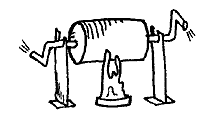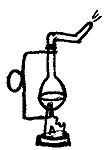


Very simple steam engines can be made from a variety of materials. Basically, they use a container of some sort, which is sealed except for the steam exit(s). The container must be fireproof, and must be able to hold water. Whatever container you use should be clean inside and out, and free of any substance or coating that may prove hazardous if heated. The steam exits are usually tubes that direct the steam so that the reaction of its escape will propel the engine in a particular direction (for every action there is an equal and opposite reaction). Lastly, the engine must be mounted on some sort of bearing so that it may freely move perpendicular to the axis of the exiting steam..
 A metal cylindrical can, sealed at both ends, is fitted with thin metal (copper) pipes in the centers of both ends. The tubes should be soldered in place. There are two bends in each tube, the first an up bend on one end, and a down bend on the other. The second bend will point forward on one end, and backwards on the other, so that the ends of the tubes point opposite, but in the same horizontal plane. The whole apparatus is partially filled with water, and the tube sections nearest the can are rested on notches in metal brackets, which raise the engine high enough to rest in the flame of an alcohol lamp.
A metal cylindrical can, sealed at both ends, is fitted with thin metal (copper) pipes in the centers of both ends. The tubes should be soldered in place. There are two bends in each tube, the first an up bend on one end, and a down bend on the other. The second bend will point forward on one end, and backwards on the other, so that the ends of the tubes point opposite, but in the same horizontal plane. The whole apparatus is partially filled with water, and the tube sections nearest the can are rested on notches in metal brackets, which raise the engine high enough to rest in the flame of an alcohol lamp.
 A nice little engine can be made with a glass tube. Seal one end of the tube in a flame, and blow a small bubble, 1/2 to 3/4 inch or so in diameter. While the glass is still soft, make a little dimple in the bottom of the bubble with a pencil. At about 2 inches above the bubble, bend the tube 90 degrees, and then bend it again 90 degrees horizontal. The end should taper somewhat, but be careful not to seal it. It is held by a piece of fairly stiff wire bent into an open-sided rectangle, the top of which is coiled to loosely hold the neck above the bubble, and the bottom of which points upwards to fit into the dimple in the bottom of the bubble. The whole apparatus needs to be clamped into place somehow, and partially filled with water. The simplest way to fill it is to heat the bulb, and place the open end under water. As the air in the bulb cools and contracts, it will draw water inside. An alcohol lamp is place beneath.
A nice little engine can be made with a glass tube. Seal one end of the tube in a flame, and blow a small bubble, 1/2 to 3/4 inch or so in diameter. While the glass is still soft, make a little dimple in the bottom of the bubble with a pencil. At about 2 inches above the bubble, bend the tube 90 degrees, and then bend it again 90 degrees horizontal. The end should taper somewhat, but be careful not to seal it. It is held by a piece of fairly stiff wire bent into an open-sided rectangle, the top of which is coiled to loosely hold the neck above the bubble, and the bottom of which points upwards to fit into the dimple in the bottom of the bubble. The whole apparatus needs to be clamped into place somehow, and partially filled with water. The simplest way to fill it is to heat the bulb, and place the open end under water. As the air in the bulb cools and contracts, it will draw water inside. An alcohol lamp is place beneath.
Eggshells can be made into steam engines. The must be emptied through a hole in one end, preferably the blunt end. The hole should be as small and centered as possible. It will not be easy to empty the egg this way, but it helps if you stick something into it first to break up the yolk. You will use 4 eggs. Wash out the shells before using them. A thimble is attached to the eggs with a rig made from very fine wire. You will need to experiment with this to get it right. The thimble should hang centered from below the egg when the egg is held horizontally. There should be a small loop in the wire rigging at the top of the egg (opposite the thimble) from which the egg will hang. The whole thing should be balanced. Suspend the whole rig by the top loop and make certain it is balanced, with the opening of the thimbles remaining horizontal. A carousel is made from a cork and two stiff wires, which are stuck in to the cork so that they protrude from 4 sides equally and perpendicularly (they should make a symmetrical cross with the cork serving as a hub). The cross should be about 4 to 5 inches across from arm tip to tip. Bend the tips to hold the egg rigs in place. Insert a straight pin into the bottom center of the cork. Balance the carousel on a metal capped bottle. If it does not balance, try pushing the wires in and out until it does. Fill the eggs about 1/4 full with water, and hang them on the carousel. They all need to point in the same circular direction (hole end to not-hole-end). If it does not balance, adjust the volume of water in the offending eggs. Half fill the thimbles with alcohol, and light. If constructed carefully, this will work very well. Do not operate it near anything flammable or any surfaces that may be damaged easily. It can (and probably will) dribble burning alcohol, so be very careful.
This article was printed from the Bizarre Labs website at bizarrelabs.com